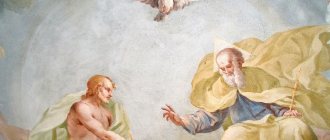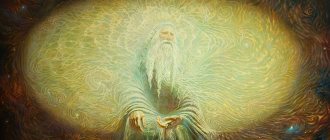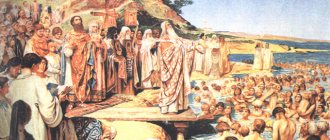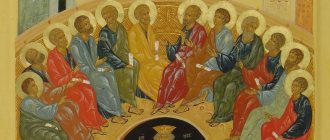The essence of pantheism
Since pantheism unites God-substance and the world-Universe, there is a need to correlate the signs of the static nature of the divine nature, such as infinity, eternity, immutability, and mobility, constant variability of the nature of the world. According to the ancient philosopher Parmenides, God and the world are inseparable from each other, while the static nature of the deity in a unique form is characteristic of all living things (like endless cyclicity). And pantheism in Hegel’s philosophy endowed God with abilities for movement and development that were usually unusual for him, thereby eliminating the main contradiction between the divine and the living. Supporters of immanent pantheism tend to see God as some kind of higher law, an eternal and unchanging force that governs the world. This line of thought was developed by Heraclitus, the adherents of Stoicism, and this, in general terms, was the pantheism of Spinoza. Within the framework of Neoplatonic philosophy, an emanative type of pantheism arose, according to which nature is an emanation derived from God. Emanational pantheism in the philosophy of the Middle Ages did not conflict with the dominant theological doctrine, but only represented a variation of realism. This kind of pantheism can be traced in the works of David of Dinan and Eriugena.
The essence and history of pantheism
The name of the philosophical movement was first voiced by Joseph Raphson in 1697. He wrote a work called "De Spatio Reali". Eight years later, the Irish philosopher John Toland wrote and described this term in English. In this work, he explained the opinion of people who do not believe in an eternal personality, and attribute a holy nature only to the Universe.
Even in ancient times, philosophers thought about where the signs of the static nature of God come from and who controls them: infinity, immutability, eternity, but at the same time the mobility and variability of the nature of the world. Many followers of this trend do not separate God and the world.
Directions of pantheism
In the history of philosophy, there were two directions that unite all pantheistic teachings:
1. Naturalistic pantheism, presented in the works of the Stoics, Bruno, and partly Spinoza, deifies nature, all living things. It is characterized by such concepts as infinite mind and world soul. This trend tends towards materialism, the reduction of the divine principle in favor of the natural.
2. Mystical pantheism developed in the doctrines of Eckhart, Nicholas of Cusa, Malebranche, Boehme, and Paracelsus. To define this direction there is a more precise term: “panentheism” - “everything is in God,” since philosophers of this direction tend to see not God in nature, but nature in God. Nature is a different level of God’s existence (objective idealism).
There are many examples of mixing both types of pantheism within the teachings of one thinker.
Origin of the term pantheism
Pantheism translated from ancient Greek means: “pan” - everyone, “theos” - God, deity. The name shows what idea the followers of the teaching adhere to. This concept focuses on the concept that God is represented by people not as the personality of the Creator, but as the Universe. It is the Universe, according to pantheists, that is the basis of everything, a single and holy substance. In this concept there is no place for the exaltation of man; pantheists do not accept anthropocentrism. Pantheistic philosophers emphasize respect for nature.
Story
The term “pantheism” (or rather “pantheist”) was first used by John Toland, an English materialist philosopher at the turn of the 17th-18th centuries. But the roots of the pantheistic worldview go back to ancient Eastern religious and philosophical systems. Thus, Hinduism, Brahmanism and Vedanta in Ancient India and Taoism in Ancient China were clearly pantheistic in nature.
The oldest religious and philosophical texts carrying the ideas of pantheism are the ancient Indian Vedas and Upanishads. For Hindus, Brahman is a boundless, permanent, impersonal essence that has become the basis for all life in the Universe, everything that has ever existed or will exist. The Upanishad text constantly affirms the idea of unity between Brahman and the surrounding world.
Ancient Chinese Taoism is a deeply pantheistic teaching, the foundations of which are set out in the work “Tao Te Ching”, written by the semi-legendary sage Lao Tzu. For Taoists, there is no creator god or any other anthropomorphic hypostasis; the divine principle is impersonal, it is akin to the concept of the path and is present in all things and phenomena.
Pantheistic tendencies are present to one degree or another in many ethnic religions of Africa, intertwined with polytheism and animism. Zoroastrianism and some sects of Buddhism are also pantheistic in nature.
In the 14th and 15th centuries in Western Europe, pantheism was in decline. The teachings of the outstanding Christian theologians John Scotus Eriugena, Meister Eckhart and Nicholas of Cusa were very close to it, but only Giordano Bruno openly supported this worldview. The ideas of pantheism were further spread in Europe thanks to the works of Spinoza.
In the 18th century, under the influence of his authority, his pantheistic sentiments spread among Western philosophers. Already at the beginning of the 19th century, pantheism was spoken of as the religion of the future. In the 20th century, this worldview was pushed aside by the ideology of fascism and communism.
The formation of pantheism since antiquity
Pantheism, as a branch of philosophy, originates long before the development of the modern world. Even in ancient times, there were people who adhered to the theory of this direction. Man has always been inclined to seek the universal Mind, since he could not control external circumstances, natural phenomena. There were entire trends in individual countries that in their essence corresponded to the modern philosophical trend:
- An ancient Indian view. Ancient Hindus considered the deity Brahman to be an impersonal entity possessing infinity and permanence. This essence in the Universe becomes the basis of all living things, determining what existed and will then exist. In various texts of Ancient India one can see that Brahman is in close relationship, unity with the world.
- Ancient Chinese view. Taoism practically repeats the basic postulates of modern philosophical pantheism. In Ancient China, the famous sage Lao Tzu wrote the work “Tao Te Ching”, which describes the main ideas of identifying the Divine Principle with the world. For the Chinese, the idea of the Great Mind is similar to the path of life. They identify God and the path, that is, divinity surrounds people in everyday life, is observed in phenomena, existing things.
- African ideas. The peoples of Africa have their own view of the Universe and Reason, which determine their existence. The peoples of Africa did not adhere to the clear doctrine of pantheism, but the ideas of this direction, polytheism, and animism were traced in their beliefs. They represented several divine beings, things possessing certain spirits. They maintained faith in the divine essence of everything that surrounds them.
Pantheistic philosophy emerged as a direction when the teachings of the Stoics began to gain popularity. Philosophers of this movement assured that the Cosmos is one organism, where everyone is interconnected and equal to each other.
John Scott presented his system to the public, where he indicated that matter, mind and God are one and the same. In the period from the 5th to the 13th centuries, several directions in philosophy developed, contradicting or confirming each other.
During the Renaissance, the philosophy of the equality of God and nature began to dawn again. In the 16th and 17th centuries, the Universe began to be understood as infinite and “thinking.” At this time, the essence of God is determined by materialism. The famous philosopher Bruno wrote a treatise on how nature is God in things. Benedict Spinoza also supported his statements. He emphasized that the objects of our ordinary world, which we feel and are aware of, are elements of the Divine Being. All categories: extension, infinity, changeability or constancy, belong to the attributes of God.
Despite the fact that this direction in philosophy constantly mentions the Divine Essence, God, the Great Mind, many scientists attribute it to a teaching close to atheism. Considering the One God to be the fundamental principle of everything, pantheists attribute the fundamental principle to dynamic matter. This leads to materialism, the understanding of the Divine Being as a kind of matter. When representatives of pantheism talk about the materiality of God, the reduction of His role in the creation of the world, and the support of ordinary people, the meaning of prayerful communication with Him and worship of Him is lost. As a result, pantheistic philosophers express godless and rebellious sentiments similar to the ideas of atheists.
The origins of pantheism in ancient philosophy
Pantheism is in the philosophy of antiquity the main element of all knowledge of the world, nature and space. It is first found in the teachings of thinkers of the pre-Socratic period - Thales, Anaximenes, Anaximander and Heraclitus. The religion of the Greeks at this time was still characterized by convinced polytheism. Consequently, early ancient pantheism is a belief in a certain animate divine principle inherent in all material things, living organisms and natural phenomena.
Pantheistic philosophy reached its highest flowering in the teachings of the Stoics. According to their doctrine, the cosmos is a single fiery organism. Stoic pantheism unites and identifies all living things, including humanity, with the cosmos. The latter is both God and a world state. Consequently, pantheism also means the original equality of all people.
During the Roman Empire, the philosophy of pantheism spread widely due to the influential position of the Stoic and Neoplatonist schools.
Middle Ages
The Middle Ages are a time of dominance of monotheistic religions, which are characterized by defining God as a powerful personality ruling over man and the whole world. At this time, pantheism was preserved in the emanation theory of Neoplatonist philosophy, which represented a kind of compromise with religion. Pantheism first appeared as a materialistic concept in David of Dinan. He argued that the human mind, God and the material world are one and the same.
Many Christian sects, recognized by the official Church as heresies and subjected to persecution, gravitated toward pantheism (for example, the Amalricans in the 13th century).
Main followers of the movement
Representatives of pantheism at different times explained and supplemented pantheistic philosophy. Among them, particularly bright personalities stood out, who wrote many works on the topic of the divinity of nature.
- Giordano Bruno. Lived during the Renaissance, developed the doctrine of God and nature. He argued that God is a universal whole, where the world mind and the world soul coincide. The whole world, according to the philosopher, is a constantly living and moving something. But Bruno went further than the ideas of his era. It is he who begins the idea of the great and heroic personality of man, whose thinking is a constantly moving basis. It was his works that marked the beginning of the transition of Renaissance philosophy to modern philosophy.
- Kuzansky Nikolai. German philosopher, cardinal and closest advisor to Pope Pius II. In his works he was based on the works of Copernicus. He wrote many works, his last works were on the same topic: the relationship between God and nature, the world. Most of the works are devoted to the problem and ways of people’s knowledge of the absolute. He owns the ideas: “the creator and the creation are one and the same,” “God is the center, the circle, He is everywhere and nowhere,” “God is in things, they are in Him.” Cusanus is of the opinion that God remains unknowable.
- Paracelsus Aureolus Theophrastus - German philosopher and physician. In nature, he saw a certain living whole, traceable in the elements of nature, the structure of a living organism, its functions. He argued that a person has unlimited possibilities if he is in close relationship with nature. Nature, in turn, has a divine origin.
Renaissance
In contrast to medieval theology, Renaissance thinkers turned to the ancient heritage and natural philosophy, paying increasingly close attention to the natural sciences and comprehension of the secrets of nature. The similarity with ancient views was limited only to the recognition of the integrity and animation of the world and space, but the methods of studying it were significantly different. The rationalistic views of antiquity (in particular, the physics of Aristotle) were rejected and the ideas of magical and occult knowledge of nature as a single spiritualized principle were promoted. A great contribution to this direction was made by the German alchemist, physician and astrologer Paracelsus, who, with the help of magic, tried to control the archaeus (soul) of nature.
It was the pantheism of the Renaissance, characteristic of many philosophical theories of that time, that was the unifying principle between such extremes as natural philosophy and theology.
Interpretation of pantheism in the teachings of Nicholas of Cusa
One of the brightest representatives of pantheism of the Early Renaissance was the famous German philosopher Nicholas of Cusa. He lived in the 15th century (1401-1464). At that time, he received a solid education and became a priest. He was very gifted, devoted to the church and had a successful career, becoming a cardinal in 1448. One of the main goals of his life was to strengthen the authority of Catholicism. Along with his active role in the church life of Europe, Cusansky devoted a lot of time to philosophical works. His views were closely related to the teachings of the Middle Ages. However, the pantheism of Nicholas of Cusa acquired the features of an inextricable organic integrity, constant movement and development of the world and, consequently, its inherent divinity. He contrasted the self-confident knowledge of the Middle Ages about God and the world with the theory of “scientific ignorance”, the main idea of which was that not a single earthly teaching is capable of providing an understanding of divine greatness and infinity.
Philosophy of Giordano Bruno
Thinker and poet, follower of Cusanus and Copernicus, the 16th century Italian philosopher Giordano Bruno was a true pantheist. He believed that all life on Earth was spiritual, endowed with a spark of divine conduct. According to his teaching, God is contained in all parts of the world without exception - the greatest and the smallest, the invisible. All nature together with man is one integral living organism.
In an attempt to create an ideological basis for the teachings of Copernicus, he put forward the theory of the existence of many worlds and a Universe that has no boundaries.
The pantheism of Giordano Bruno, an Italian thinker of the 16th century, later became a classic concept for the Renaissance.
Modern ideas of pantheism
Modern philosophy is permeated with the ideas of pantheism. This movement has become an important element of many theories and religions. In the modern world, some ideas of the direction are used by environmentalists, whose goal is to improve the ecology and conditions of the human environment.
At the end of the 20th century, societies based on such a movement as the “World Pantheistic Movement” appeared in world philosophy. Pantheism is good for perception by society as a direction for protecting the planet's biosphere from gross interference by human activity. At the moment, the philosophical movement is not perceived as a separate religion.
Pantheism in the philosophical doctrine of B. Spinoza
The philosophical heritage of B. Spinoza is the most striking concept of pantheism created in modern times. To present his vision of the world, he used the geometric method, as he himself called it. He was guided by him when creating the fundamental work “Ethics,” dedicated to philosophical metaphysics, nature, God, and man. A separate section is devoted to the human mind, feelings, moral and ethical problems. The author presents definitions for each question in strict sequence, followed by axioms, then theorems and their proofs.
At the center of Spinoza's doctrine is the idea of the identity of God, nature and substance. The priority of the divine, its dominant role in the overall picture of the world, are characteristic of the philosophy of the New Age. But Spinoza, following Descartes, defends the point of view that the existence (being) of God must be proven. Based on the arguments of his predecessor, he significantly expanded his theory: Spinoza abandoned the original givenness, the a priori nature of the existence of God. But proof of this is possible thanks to the following postulates:
- there is an infinite number of knowable things in the world;
- the limited mind is not able to understand the unlimited truth;
- knowledge is impossible without the intervention of an external force - this force is God.
Thus, in Spinoza’s philosophy there is a combination of the infinite (divine) and the finite (human, natural), the very existence of the latter proves the presence of the former. Even the thought of the existence of God cannot appear independently in the human consciousness - it is put there by God himself. This is where Spinoza's pantheism manifests itself. The existence of God is inseparable from the world, impossible outside of it. Moreover, God is related to the world, he is inherent in all its manifestations. He is simultaneously the cause of the existence of all living and nonliving things in the world and the cause of his own existence. Following the established philosophical tradition, Spinoza declares God to be an absolute infinite substance, endowed with many properties characterizing its eternity and infinity.
If other representatives of pantheism built a dualistic picture of the world, where there are two poles - God and nature, then Spinoza rather deifies the world. This is some kind of reference to ancient pagan cults. Living nature in its eternal cyclical development is God, giving birth to himself. Divine nature is not something separate, delimited from the material world; on the contrary, it is immanent, internally inherent in all living things. The anthropomorphic, personalized interpretation of God, accepted in most religions, is absolutely alien to Spinoza. Thus, natural philosophy and pantheism of the Renaissance found their most complete embodiment in a single doctrine.
Main directions
There are several areas of theory in which the philosophical movement is revealed from several sides:
- Theomonistic pantheism - some Divine substance appears to be eternal and unchangeable. Representatives of this direction give the powers of existence only to God, while the natural world cannot exist independently.
- Physiomonic - Philosophers endow nature with divine power, which they call the “god” of all people. By doing this they deprive God of his independent existence.
- Mystical - panentheism. This is the doctrine that the world abides in God, but not God in it. The world is understood as a way of demonstrating the strength and power of God.
- Immanent-transcendent - Proponents argue that God manifests through things.
All these theories are based on the relationship between the Divine essence, nature, and the Universe. In this regard, man does not occupy the first place, but is subordinate to a certain substance endowed with Divine power.








